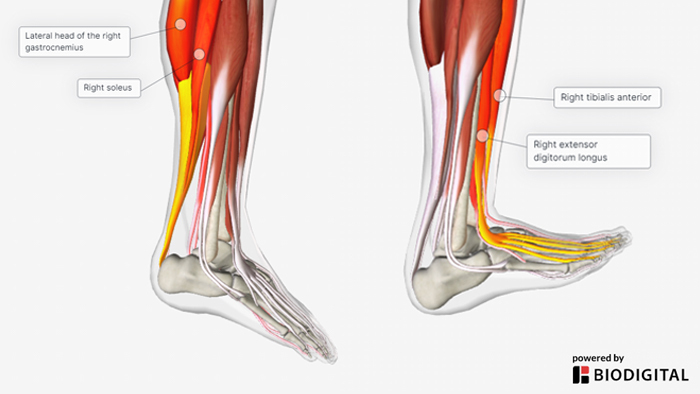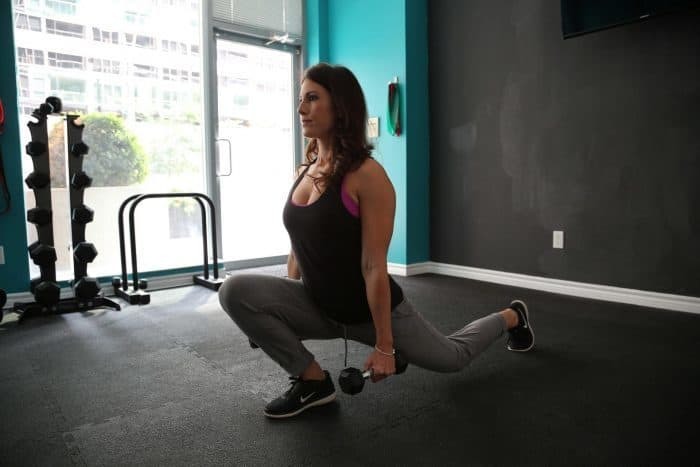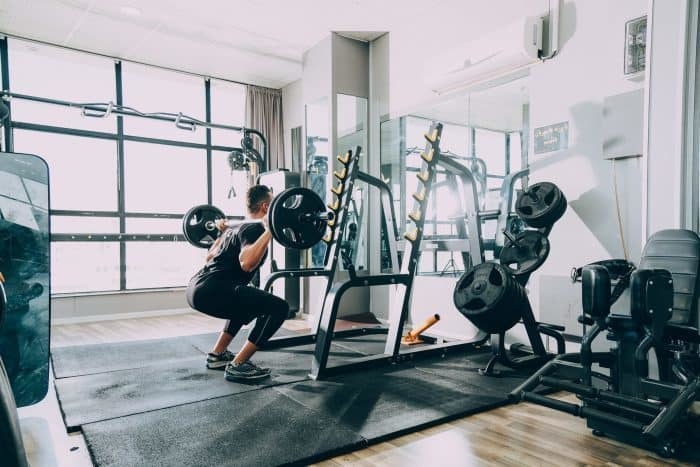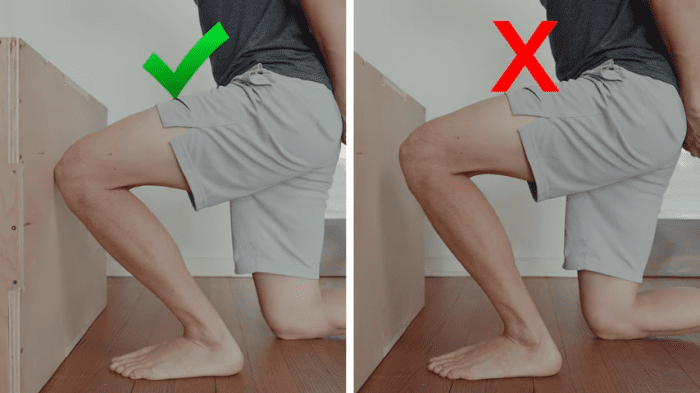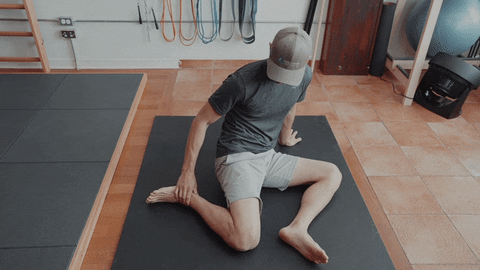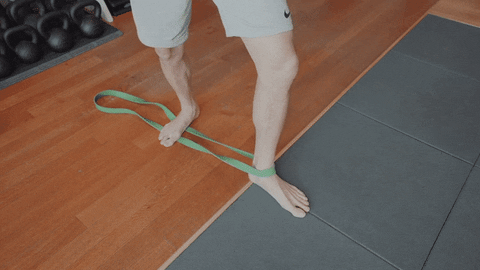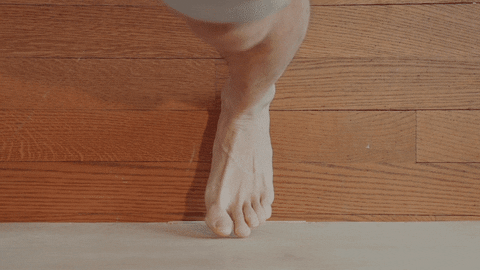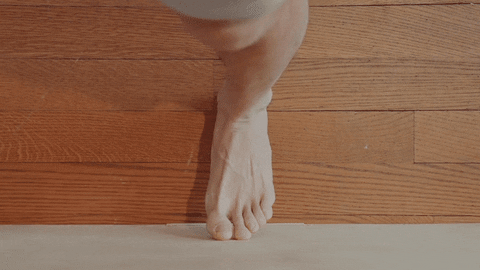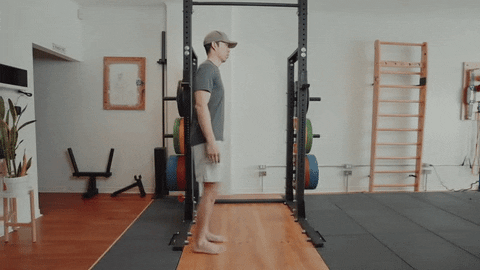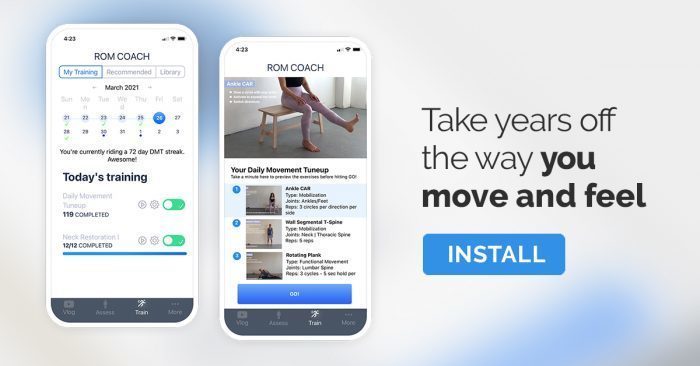
Though ankle dorsiflexion may not be a range of motion you think about regularly, it’s actually really important. You might not be aware of your level of ankle dorsiflexion, which is why I highly recommend testing it so that you can take steps to improve your ankle mobility and stability if necessary.
We’ll cover all of this in detail, but first, what is ankle dorsiflexion anyway?
Your ankle is a hinge joint. Just like hinges on a door, it can move in only one plane. There are two main movements of the ankle joint, one being plantarflexion, which is what happens when you point your toes or do a calf raise. This involves flexing your toes away from your shin.
The other movement, which we are talking about today is ankle dorsiflexion. This is when you pull your toes toward your knee or when your foot is planted on the ground and your knee goes forward of the foot, like it would in a lunge.
This seemingly simple movement is critical for a lot of reasons! Let’s dive into those first and then we’ll get into how to test your dorsiflexion and the exercises I recommend to improve it.
Why is Ankle Dorsiflexion Important?
When it comes to physical activity and exercise, ankle dorsiflexion plays an important role. Many of us, myself included, incorporate squatting into our exercise routines. Deeper squats are more effective, and to get deep with your squats, you need ankle dorsiflexion. In fact, many studies including this one, show that dorsiflexion range can limit your squat depth. [1]
I also enjoy playing ice hockey, which is another form of movement that depends on ankle dorsiflexion. Ankle dorsiflexion maximizes your stride length making it easier to move around on the ice.
Ultimately, the biggest reason that ankle dorsiflexion is important is injury prevention. Because the body is so inherently connected, poor ankle dorsiflexion can affect not only your ankles, but your knees and hips as well. There are a number of injuries from feet to hips that are directly related to a lack of dorsiflexion
When you lack ankle dorsiflexion, you absorb more forces that are going through the body. Good dorsiflexion means the ankle takes more force and there’s less stress on the knees and hips.
Let’s look into some of the specific types of injuries that are associated with poor dorsiflexion.
Injuries Related to Poor Dorsiflexion
Naturally, ankle sprains are correlated with inflexible ankles. In fact, in this systematic review [2] of twenty-one different studies on ankle dorsiflexion, the authors concluded that people with inflexible ankles have nearly five times the risk of ankle sprain than people with average flexibility.
Moving up from the ankle, here are more common injuries that studies suggest are related to ankle dorsiflexion:
- Achilles tendinopathy [3]
- ACL tears [4]
- Patellar tendinopathy (or jumper’s knee) [5]
- Patellofemoral osteoarthritis [6]
- Hamstring tears [7]
As you can see, ankle dorsiflexion is a pretty important ROM and poor dorsiflexion can impact the body in several ways. The first step in preventing these types of injuries related to ankle dorsiflexion is becoming aware of your own ankle flexibility.
Does Your Ankle Dorsiflexion Need Improvement?
There are a few signs you can look for that will give you clues about your ankle flexibility. The first thing to pay attention to is if you are able to squat deeply without your heels coming off the floor. If you find that you have trouble performing deep squats, your ankle dorsiflexion may need some improvement.
Another sign is a history of overpronation. When you’re walking do your feet flatten out and turn out a little? (If so, learn how to correct overpronation here.) Lastly, a history of ankle sprains is another hint that you might need to improve your dorsiflexion.
Whether these signals apply to you or not, it’s still a good idea to test this important ROM.
How to Test Your Dorsiflexion ROM
The weight bearing lunge test is an easy way to test your ankle dorsiflexion. Here’s how you do it:
- Start by kneeling on one knee, with the opposite foot about a handprint away from the wall.
- Try to touch the wall with your knee while still keeping your foot flat on the ground.
If your knee touches the wall, congrats you pass! This indicates that you should have good dorsiflexion for general movement.
If it doesn’t, it’s probably a good idea to prioritize this important range of motion and work on your dorsiflexion.
Be mindful of compensations your body may be making when trying this test. Pay attention to your foot as you move and make sure that your arch isn’t collapsing and that your foot isn’t flattening out. Secondly, look for tibial external rotation which is turning your foot out when you do the movements.
Keep these compensations in mind when doing the following exercises as well. This test can also be used to track your progress once you’ve begun doing the exercises by measuring the space between your foot and the wall. Here are the exercises that I recommend:
4 Ankle Dorsiflexion Exercises for Mobility and Stability
When it comes to improving ankle flexibility, you may be picturing calf stretches. However, the following four techniques will improve dorsiflexion more quickly and effectively than traditional static stretching.
The first two techniques involve more passive forms of movement, which pair really well with the last two, more active exercises. This combination of exercises is intended to give you great results when it comes to ankle mobility and stability.
1. Active Self-Myofascial Release Technique
This first exercise which involves myofascial release of the calves and achilles helps ensure that you have the tissue pliability needed to get deeper into ankle dorsiflexion.
- Start seated on the floor in the 90/90 position with your ankle in plantarflexion- your toes pointed. Then, place your thumb near the rear foot between the ankle and achilles area.
- Begin dorsiflexing the ankle, while sliding the thumb up, bringing pressure into the calf and tendon. Hit different areas and work your way up the leg, targeting the area between the two bones of the shin. Spend about a minute to two minutes here.
- Then move to the same area but on the other side of your front leg and work it for another one to two minutes.
- Next switch your 90/90 position and repeat. Once again, start on the lateral side of the rear leg then work the medial side of the front leg for a minute or two on each side.
It’s not necessary for your timing to be exact here, just make sure that you are moving slow enough to really work the tissue. After the first week or two of doing this consistently, you will likely find that you don’t have to spend as much time on this technique.
This technique has been shown to be effective in research. A study in the Journal of Athletic Training [8] looked into the effectiveness of a similar technique and found that even a single session can make a positive improvement in ankle dorsiflexion.
2. Banded Dorsiflexion Mobilization
For this next exercise, you will need a belt or resistance band and something to step on, like a yoga block or platform.
- Create tension by using one foot to step on your belt or band and wrap the other end around the ankle of the foot that will be on the platform. Lunge forward as far as possible, sending your knee past your toes. Be sure to keep your foot grounded.
- Hold for five seconds. Reset and repeat for ten reps then do the same thing on the other side.
This technique also has research to back it up. A 2015 study [9] showed that after three weeks this technique significantly improved ankle dorsiflexion and was superior to static stretching for all measures.
3. Ankle Dorsiflexion Level II ERE
The next two active techniques were developed to make sure that you lock in the gains that you achieve with more passive techniques like the two listed above.
ERE stands for End Range Expansion which brings you actively into the range of motion that you are trying to gain. This means that the muscles that bring you into and out of a range of motion are strengthened. This exercise involves five separate muscular activation patterns.
- To begin, place your forefoot (the ball of your foot and toes) on a wall at your active end range of dorsiflexion.
- From here, use your dorsiflexion muscles to lift your foot off the wall and hold for about ten seconds or a couple of slow breaths.
- Slowly lower your foot back to the wall.
- Next, activate your calves to press into the wall for the same amount of time.
After that, practice ankle eversion, by turning the bottom of the foot to the outside; hold that end range for ten seconds. Perform ankle inversion next, by turning the bottom of the foot the opposite way, toward the inside.
Lastly, perform one more activation of the dorsiflexor muscles, really activating the muscles as powerfully as you can. Hold there for another ten seconds and breathe deeply. This makes up one cycle.
Switch sides and repeat, doing two to four cycles each side.
The ERA technique strengthens the muscle that is primarily responsible for getting you into dorsiflexion range. This muscle, the tibialis anterior muscle, is also associated with shin splints, which also makes this exercise beneficial for preventing those.
4. One Leg Anterior Reach
Our last exercise, the 1-leg anterior reach is relatively simple. This one is performed by sliding one foot out in front of you while doing a single leg squat with the other, supporting leg.
- It’s best to do this in bare feet. Allow the knee of your support leg to travel as far past the toes as possible as this is what trains the dorsiflexion and locks it into this functional movement pattern.
- Perform two to three sets of six to eight reps per side.
These four exercises performed two-three times per week will greatly improve your ankle dorsiflexion and help prevent injury.
Let's recap this routine:
Exercises | Sets |
|---|---|
ASMR | 1 set x 1-2 min per |
Banded Dorsiflexion Mobilization | 1-2 sets x 10 reps per with 5s hold |
Ankle Dorsiflexion Level II ERE | 2-4 cycles per - 10s holds |
1-Leg Anterior Reach | 2-3 sets x 6-8 reps per |
If you’re ready to commit to improving your ankle dorsiflexion, we have some resources that can help you. These four exercises can be easily accessed and followed on the ROM Coach app, which is free to download!
You can even add this routine to your calendar and set notifications to remind you when to do it. Progression is also built into the app, so all you have to do is follow along and get it done.
In order to prevent injury and maintain a lifetime of movement, ankle dorsiflexion is definitely something to be aware of. I hope that after reading this article, you have a better idea of your own ankle flexibility and mobility and are inspired to take action to improve this important ROM.
----
This article was reviewed and updated on March 10, 2022 by our Chief Medical Officer, Dr. Erin Boynton, MD, FRCS to include to include new research, exercises and information on latest surgical developments. Read more about Dr. B here.
References & Resources:
[1] Kim, S. H., Kwon, O. Y., Park, K. N., Jeon, I. C., & Weon, J. H. (2015). Lower extremity strength and the range of motion in relation to squat depth. Journal of human kinetics, 45, 59–69.
[2] de Noronha, M., Refshauge, K. M., Herbert, R. D., Kilbreath, S. L., & Hertel, J. (2006). Do voluntary strength, proprioception, range of motion, or postural sway predict occurrence of lateral ankle sprain?. British journal of sports medicine, 40(10), 824–828.
[3] Rabin, A., Kozol, Z., & Finestone, A. S. (2014). Limited ankle dorsiflexion increases the risk for mid-portion Achilles tendinopathy in infantry recruits: a prospective cohort study. Journal of foot and ankle research, 7(1), 48.
[4] Wahlstedt, C., & Rasmussen-Barr, E. (2015). Anterior cruciate ligament injury and ankle dorsiflexion. Knee surgery, sports traumatology, arthroscopy : official journal of the ESSKA, 23(11), 3202–3207.
[5] Scattone Silva, R., Nakagawa, T. H., Ferreira, A. L., Garcia, L. C., Santos, J. E., & Serrão, F. V. (2016). Lower limb strength and flexibility in athletes with and without patellar tendinopathy. Physical therapy in sport : official journal of the Association of Chartered Physiotherapists in Sports Medicine, 20, 19–25.
[6] Tan, J. M., Crossley, K. M., Munteanu, S. E., Collins, N. J., Hart, H. F., Donnar, J. W., ... & Menz, H. B. (2020). Associations of foot and ankle characteristics with knee symptoms and function in individuals with patellofemoral osteoarthritis. Journal of foot and ankle research, 13(1), 1-10.
[7] Malliaropoulos, N., Bikos, G., Meke, M., Vasileios, K., Valle, X., Lohrer, H., Maffulli, N., & Padhiar, N. (2018). Higher frequency of hamstring injuries in elite track and field athletes who had a previous injury to the ankle - a 17 years observational cohort study. Journal of foot and ankle research, 11, 7.
[8] Stanek, J., Sullivan, T., & Davis, S. (2018). Comparison of Compressive Myofascial Release and the Graston Technique for Improving Ankle-Dorsiflexion Range of Motion. Journal of athletic training, 53(2), 160–167.
[9] Jeon, I. C., Kwon, O. Y., Yi, C. H., Cynn, H. S., & Hwang, U. J. (2015). Ankle-Dorsiflexion Range of Motion After Ankle Self-Stretching Using a Strap. Journal of athletic training, 50(12), 1226–1232.
Precision Movement - How to Correct Overpronation (Fix these 3 Different Causes)

